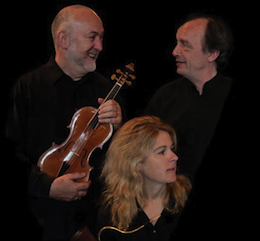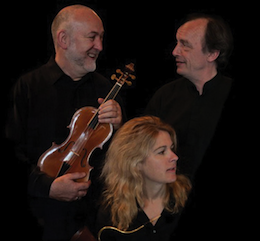
The San Francisco Early Music Society sponsored a collaboration Sunday between veteran violinist John Holloway, harpsichordist Lars Ulrik Mortensen, and the estimable Australian bassoonist Jane Gower. The trio was on a record promotion tour, hawking its new album of trio sonatas by Dario Castello (d. 1656) and Giovanni Fontana (d. 1631) on the ECM label. The performances were as musical and assured as I expected from these first-rate artists, and the selections were sufficiently balanced and diverse to maintain musical interest throughout the program, which is a risk with this type of ensemble and repertory.
The dulcian provided the concert’s musical novelty. With much of musical history, I believe it is improper to speak of progress or improvement to describe various changes in instrument construction and musical styles occurring over the centuries. (Changes favoring loudness as a result of the economics of concert production often come at the expense of tone quality and resonance, as is the case with modern string instruments.) Possible exceptions are the double reed instruments, where a series of improvements to better the instrument’s ease of playing and consistency of tone can be viewed on a continuum.
The Renaissance/early Baroque dulcian sounds quite crude, unblended, and rough compared to its later bassoon counterpart. The main difference is that the dulcian is carved out of a single piece of wood, whereas bassoons are hewn in sections, allowing the instrument maker more opportunity to refine the construction because there are more points of entry. This contrasted with the gracious and coruscated tones of the Baroque violin and harpsichord, as if a street urchin had crashed the fancy-dress ball. Then again, there are compositions celebrating this tonal contrast.
Gower’s dulcian playing belied how difficult it is to control this ungainly instrument.
Gower’s dulcian playing belied how difficult it is to control this ungainly instrument, and her mastery allowed the trio to explore an infrequently performed repertory of trio sonatas for this combination. Many of the trio sonatas followed the imitative counterpoint model of “I’ll play it first, then it’s your turn,” which in the case of the blazing-fast runs of Castello’s seventh sonata, Book II, meant throwing down the gauntlet of relatively straightforward violin passages to the dulcian, to be tackled and somehow accomplished. Gower made it look easy.
The compositions for this unique combination also exploited the timbral and pitch differences, providing a breath of fresh air to the normal fast-slow-fast routine of the trio sonata genre. Fontana’s ninth sonata was especially effective in this regard, and this work would not have quite the same impact if the dulcian part was played on a cello. Johann Rosenmüller’s (1619–1684) sonata in D was less creative in this regard, where the counterpoint felt too predictable and the dulcian part too violinistic.
Mortensen’s continuo support was sensitive and florid throughout the evening.
The trio wisely interspersed the trio sonatas with other solo works and duets. Most memorable was Holloway’s performance of Heinrich Biber’s justly famous passacaglia for violin solo. Holloway has a long association with this piece, and I was surprised he did not play it from memory. Elsewhere, as in Philip Freidrich Buchner’s sonata Op. 4, No. 8, and Marco Uccellini’s La Luciminia contenta (Happy Luciminia), he revealed how he must have been listening to singers in his free time, or on other jobs, through his mimicry of vocal ornamentation and improvisation.
Mortensen’s continuo support was sensitive and florid throughout the evening , and he complemented this with solo keyboard works by Froberger (1616–1667) and a famous toccata by Michelangelo Rossi (1601–1656). I found Mortensen’s body language and facial expression overly animated and distracting, but, looking away, I could still hear his ability to delineate counterpoint and impose some structure out of Rossi’s exuberant form. Gower returned with solo works for dulcian such as a canzona by Bartolomeo Selma y Salaverde (1580–1638), an idiomatic work that exploited the full range of the instrument’s capacity.

